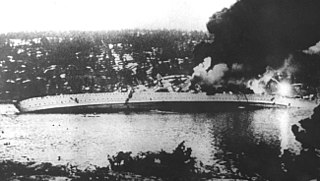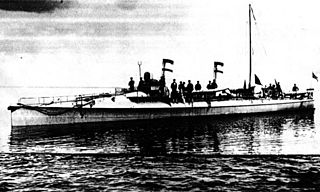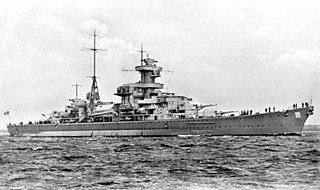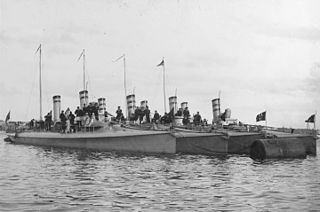
The Royal Norwegian Navy is the branch of the Norwegian Armed Forces responsible for naval operations of Norway, including those of the Norwegian Coast Guard. As of 2008, the Royal Norwegian Navy consists of approximately 3,700 personnel and 70 vessels, including 4 heavy frigates, 6 submarines, 14 patrol boats, 4 minesweepers, 4 minehunters, 1 mine detection vessel, 4 support vessels and 2 training vessels.

The Oslofjord is an inlet in southeastern Norway. The 120-kilometre (75 mi) fjord begins at the small village of Bonn in Frogn Municipality and stretching northwards to the city of Oslo, and then curving to the west and then south again. It then flows south to an imaginary line running between the Torbjørnskjær Lighthouse and Færder Lighthouse where it becomes part of the Skagerrak strait. The Skagerrak connects the North Sea and the Kattegat sea area, which leads to the Baltic Sea. The Oslofjord is not a fjord in the geological sense, but in the Norwegian language, the term fjord can refer to a wide range of waterways including inlets such as this one.

Deutschland was the lead ship of her class of heavy cruisers which served with the Kriegsmarine of Nazi Germany during World War II. Ordered by the Weimar government for the Reichsmarine, she was laid down at the Deutsche Werke shipyard in Kiel in February 1929 and completed by April 1933. Originally classified as an armored ship by the Reichsmarine, in February 1940 the Germans reclassified the remaining two ships of this class as heavy cruisers. In 1940, she was renamed Lützow, after the unfinished Admiral Hipper-class heavy cruiser Lützow was sold to the Soviet Union the previous year.

Leif Welding-Olsen was the commander of the Royal Norwegian Navy patrol boat HNoMS Pol III. He was the first Norwegian to be killed during the German invasion of Norway. On 8 April 1940, Leif Welding-Olsen raised the alarm as the German navy ships moved past the guard lines in outer Oslofjord. Norway had been attacked at 2205hrs that evening as German ships passed the Norwegian territorial borders. Captain Welding-Olsen had a brief conversation with the commander of one of the German torpedo boats, who demanded that he surrender, but Welding-Olsen refused. Realizing that the enemy would not turn away, and was going to violate Norwegian neutrality, Pol III fired flares to alert Norwegian coastal batteries and rammed the Albatros.

The Battle of Drøbak Sound took place in Drøbak Sound, the northernmost part of the outer Oslofjord in southern Norway, on 9 April 1940. It marked the end of the "Phoney War" and the beginning of World War II in Western Europe.

The Admiral Hipper class was a group of five heavy cruisers built by Nazi Germany's Kriegsmarine beginning in the mid-1930s. The class comprised Admiral Hipper, the lead ship, Blücher, Prinz Eugen, Seydlitz, and Lützow. Only the first three ships of the class saw action with the German Navy during World War II. Work on Seydlitz stopped when she was approximately 95 percent complete; it was decided to convert her into an aircraft carrier, but this was not completed either. Lützow was sold incomplete to the Soviet Union in 1940.

HNoMS Olav Tryggvason was a minelayer that was built by the naval shipyard at Horten in the early 1930s with the yard number 119. She served in the Royal Norwegian Navy until captured by the Germans in 1940. The Germans renamed her first Albatros II, and a few days later Brummer. She was wrecked in a British bombing raid in northern Germany in April 1945.

HNoMS Rauma was an Otra-class minesweeper built in 1939 for the Royal Norwegian Navy. Captured by the Germans during the 1940 invasion of Norway and renamed Kamerun, she was returned to the Norwegians after the end of the Second World War and recommissioned in 1947. Rauma remained in service until being sold for scrapping in 1963.

HNoMS Sæl was the penultimate vessel of the ten 1. class torpedo boats of the Royal Norwegian Navy. She was built at the Royal Norwegian Navy Shipyard in Horten in 1901, with yard number 85. She was to see close to 40 years service with the Royal Norwegian Navy, taking part in the preparations for war in connection with the dissolution the union with Sweden in 1905, enforcing Norwegian neutrality during the First World War and opposing the German invasion of Norway in 1940. She was lost in battle with Kriegsmarine vessels at Ånuglo in the Hardangerfjord on 18 April 1940.

Operation Weserübung was Germany's assault on Denmark and Norway during the Second World War and the opening operation of the Norwegian Campaign.

Blücher was the second of five Admiral Hipper-class heavy cruisers of Nazi Germany's Kriegsmarine, built after the rise of the Nazi Party and the repudiation of the Treaty of Versailles. Named for Gebhard Leberecht von Blücher, the Prussian victor of the Battle of Waterloo, the ship was laid down in August 1936 and launched in June 1937. She was completed in September 1939, shortly after the outbreak of World War II. After completing a series of sea trials and training exercises, the ship was pronounced ready for service with the fleet on 5 April 1940. She was armed with a main battery of eight 20.3 cm (8.0 in) guns and, although nominally under the 10,000-long-ton (10,000 t) limit set by the Anglo-German Naval Agreement, actually displaced over 16,000 long tons (16,000 t).

The Type 23 torpedo boat was a group of six torpedo boats built for the Reichsmarine during the 1920s. As part of the renamed Kriegsmarine, the boats made multiple non-intervention patrols during the Spanish Civil War in the late 1930s. During World War II, they played a minor role in the Norwegian Campaign of 1940, Albatros being lost when she ran aground. The Type 23s spent the next several months escorting minelayers as they laid minefields and escorting ships before the ships were transferred to France around September. Möwe was torpedoed during this time and did not return to service until 1942. They started laying minefields themselves in September and continued to do so for the rest of the war.

HNoMS Brand was a 1.-class torpedo boat constructed in 1898. She served the Royal Norwegian Navy for more than four decades, including neutrality protection duties during the First World War. Having once again been employed on neutrality protection duty at the outbreak of the Second World War, Brand was captured by the Germans during their invasion of Norway in April 1940.

The Action in the Oslofjord occurred late on 8 April 1940 in World War II. As Kampfgruppe 5 of the German invasion force proceeded towards Oslo, it encountered Norwegian defences in the Oslofjord. During a short exchange that resulted in the first Norwegian casualty of the war, the Germans managed to push through down to Drøbak Sound, where they would face more determined resistance.
The Battle of Horten Harbour or the Action at Horten was an engagement that occurred on 9 April 1940. It took place during Operation Weserübung, when the Germans launched an amphibious assault on Karljohansvern, the Norwegian naval base at Horten. After being initially repulsed by Norwegian naval units, German troops headed overland to outflank the base, forcing it to capitulate.


Kondor was the fifth of six Type 23 torpedo boats built for the German Navy. The boat made multiple non-intervention patrols during the Spanish Civil War in the late 1930s. During World War II, she played a minor role in the attack on Oslo, the capital of Norway, during the Norwegian Campaign of 1940. Kondor spent the next several months escorting minelayers as they laid minefields and damaged heavy ships back to Germany before she was transferred to France around September. She started laying minefields herself that month and continued to do so for the rest of the war. The boat returned to France in 1942 and helped to escort blockade runners, commerce raiders and submarines through the English Channel and the Bay of Biscay. Damaged by a mine shortly before the Allied Invasion of Normandy in June 1944, Kondor was under repair on the day of the landings. Recognizing that she could not be repaired quickly, the boat was decommissioned later that month and was then further damaged by British bombers so that she was declared a constructive total loss.

Möwe was the lead ship of her class of six torpedo boats built for the German Navy. The boat made multiple non-intervention patrols during the Spanish Civil War in the late 1930s. During the Norwegian Campaign of 1940, she played a minor in the attack on Oslo, the capital of Norway. Möwe was torpedoed and badly damaged by a British submarine in May and did not return to active service until 1942 when she was transferred to France. The boat helped to escort blockade runners, commerce raiders and submarines through the Bay of Biscay. She also laid numerous minefields and attacked Allied ships during the Invasion of Normandy in June 1944. Möwe was sunk by British bombers that same month.
















